Have you ever looked at a huge cruise ship and wondered how it floats? The key is in the science of buoyancy, weight distribution, and hull design. It also depends on what materials the ship is made of, along with safety features.
Buoyancy is a key point in a ship’s ability to float. It’s the force pushing up on an object when it’s in a liquid or gas. Since cruise ships are huge, they push aside enough water to support their weight.
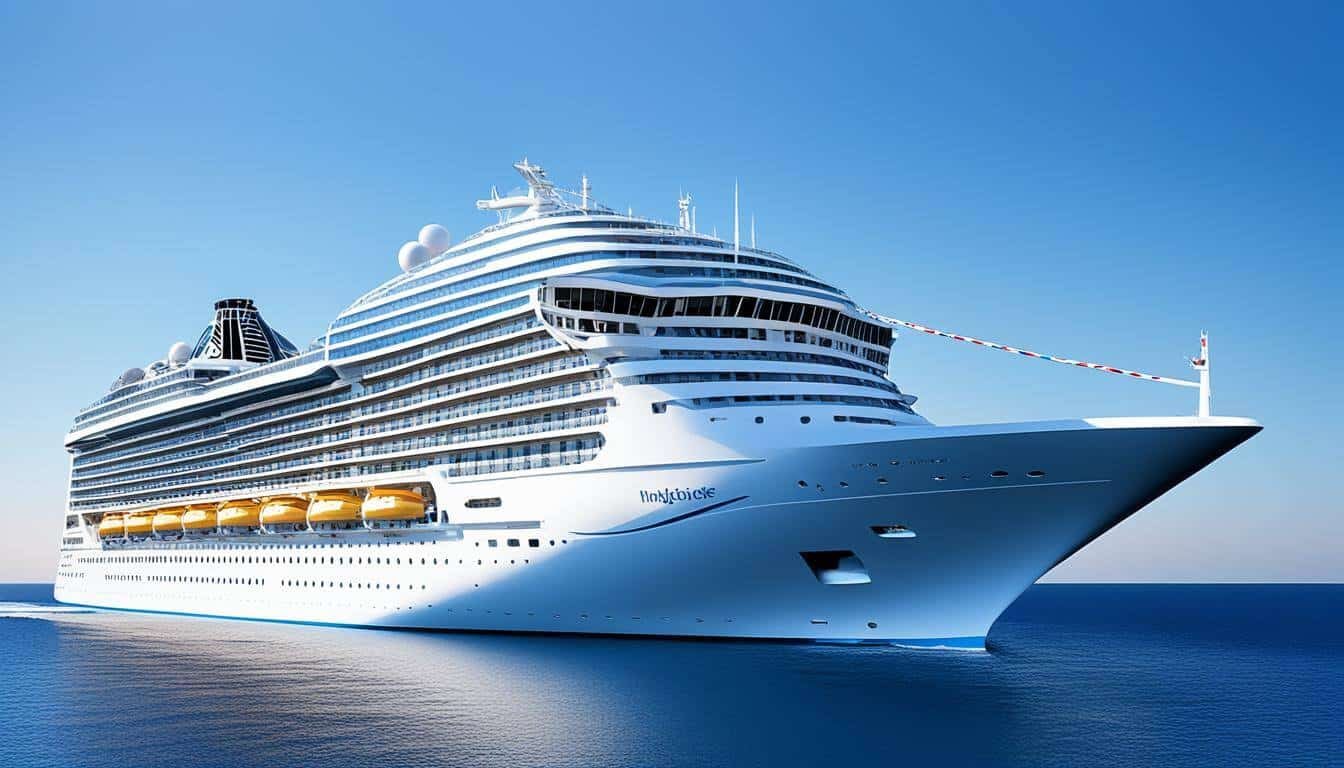
The hull shape is important for a ship to stay up. Cruise ships have a shape that makes water move around them smoothly. This shape reduces drag and helps the ship float.
How the ship’s weight is spread out and what it’s made of also matter. Cruise ships are designed to use materials like steel that are strong but not too heavy. This helps keep the ship upright.
For safety, ships have watertight areas. If water gets in, these areas keep the ship from sinking. This system helps passengers and crew feel secure during their trip.
Knowing about how cruise ships float shows the amazing work behind their design. It’s a great example of humans using science and engineering to do incredible things.
Key Takeaways:
• Cruise ships float due to the principles of buoyancy, weight distribution, hull design, construction materials, and safety features.
• Buoyancy is the upward force exerted by a liquid or gas on a submerged object, keeping the ship afloat by displacing an equal weight of water.
• The shape of the hull, including a bulbous bow and tapered stern, reduces drag and increases speed.
• Weight distribution is carefully engineered to maintain a low center of gravity and evenly distribute weight throughout the ship.
• Durable materials like steel are used to construct cruise ships, providing both buoyancy and structural integrity.
• Safety features such as watertight compartments ensure the ship remains afloat, even in emergencies.
The Principle of Buoyancy
Buoyancy is what makes ships float, including huge cruise ships. It explains the upwards push from a liquid or gas on an object in it. For cruise ships, buoyancy is why they stay on top of the water and move without sinking.
Buoyancy’s famous friend, Archimedes Principle, adds that an object in a fluid gets an upwards push that equals the fluid it moves. Apply this to cruise ships: the water they displace weighs as much as the ship. This balance in forces keeps the ship floating.
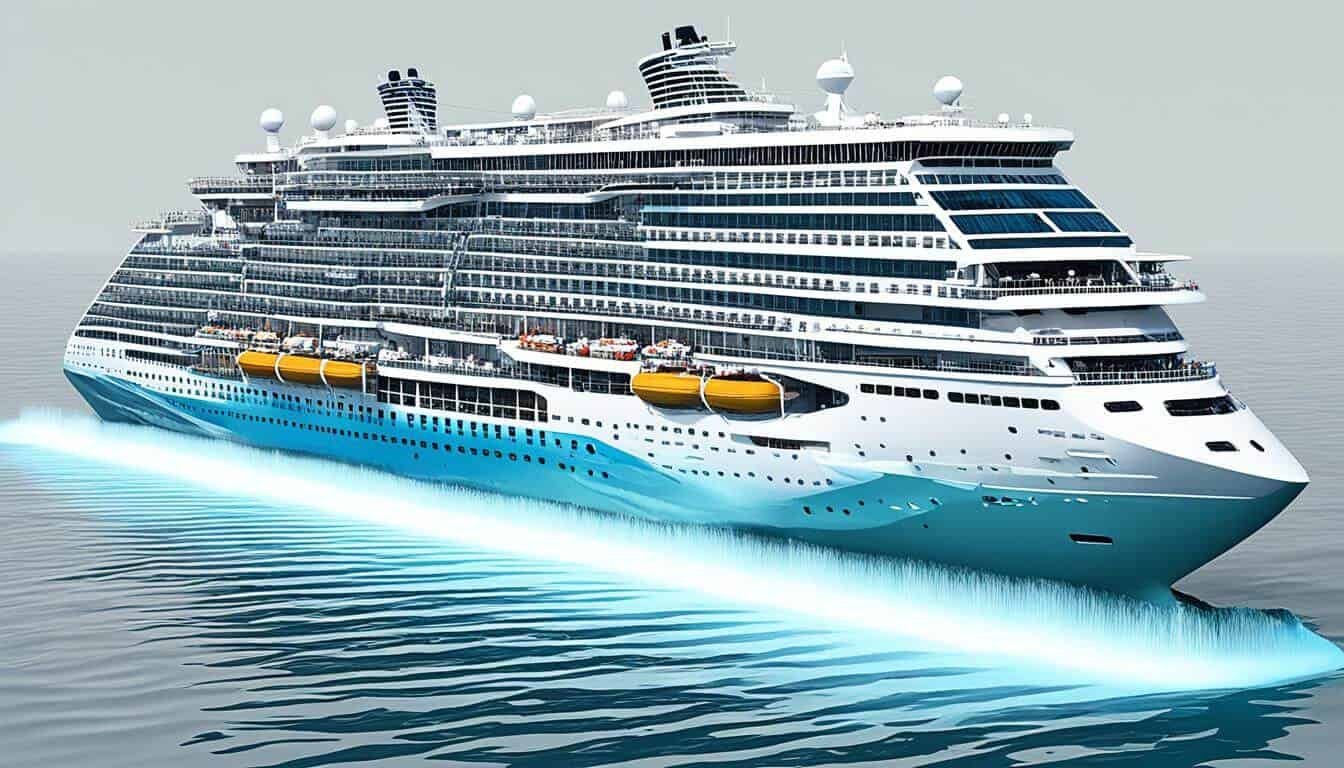
Picturing a big cruise ship in a pool helps understand. The ship’s weight presses down the water. The water then pushes back, keeping the ship up. This is how a ship floats.
This image shows a cruise ship gliding smoothly on water. It helps us really get how buoyancy works. The picture complements the text, making the idea clear.
Cruise ships also consider other things like hull shape, how weight is spread out, and the materials they use. All these details are essential for a ship’s balance and steady movement through water.
The Shape of the Hull
The shape of a cruise ship’s hull is key to its ability to stay afloat. Designers shape it for top-notch buoyancy, ensuring a smooth and safe ride for everyone onboard. A well-designed hull keeps the ship stable in the water.
The front of a cruise ship has a unique, bulbous bow. This shape helps the ship move faster by reducing water resistance. It lets the water flow around the ship without disruption. At the back, a tapered stern improves how the ship moves through water, making it more efficient.
The hull also has a curved design, which helps with lift and buoyancy. Its shape aids the ship in displacing water effectively. This ensures the ship can stay afloat and operate well in the ocean.
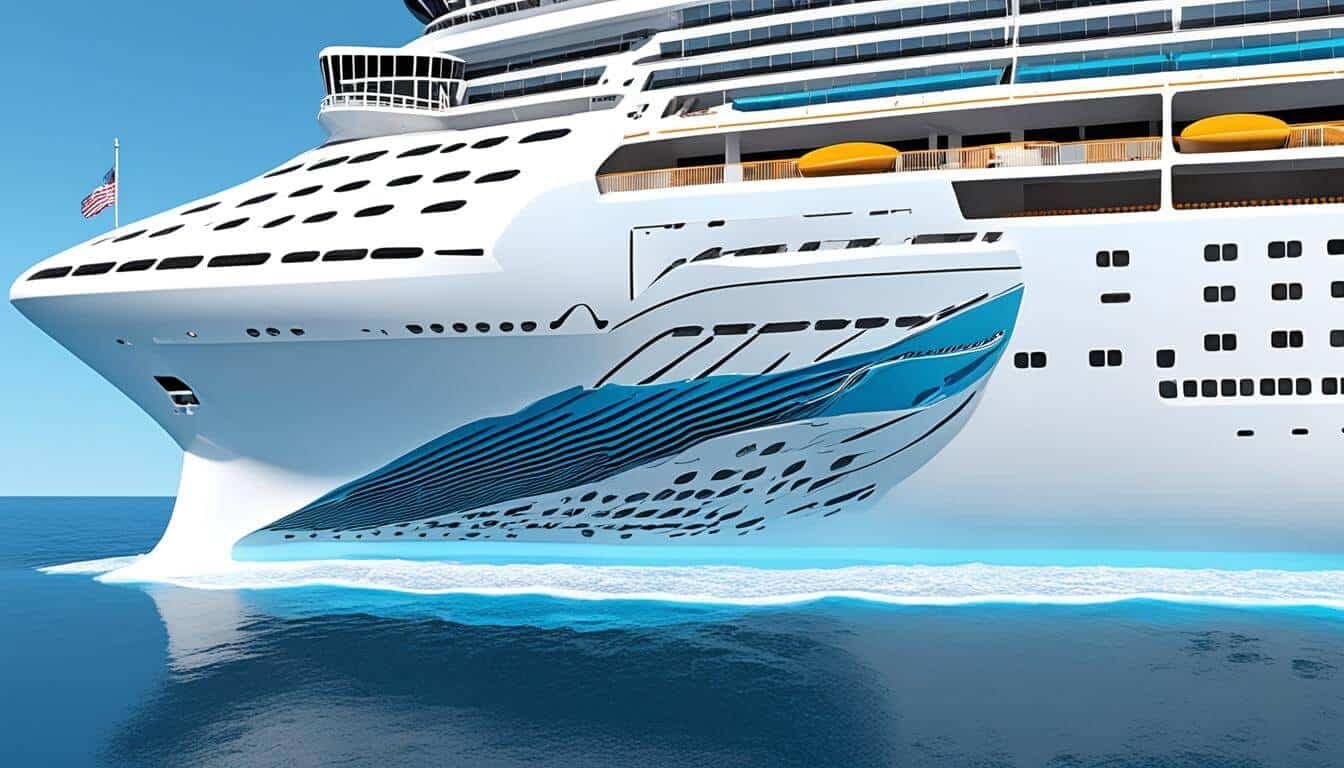
Considering the hull’s shape carefully, designers make sure the ship is steady and ready for all types of seas. It’s about keeping everything in balance to ensure a great sea voyage.
Weight Distribution and Construction Materials
Weight distribution and the materials used are vital for a cruise ship’s flotation. It makes sure the ship’s weight is spread out well. This keeps the ship from tipping. The heaviest parts are put on lower decks to lower the ship’s center of gravity, helping keep it stable.
Using materials like steel is important for a cruise ship to float. Steel is lightweight but very strong. It allows the ship to be strong yet light enough to float safely. This balance is key for a secure and steady voyage.
Now, let’s dig into displacement, which is how much water the ship moves. This action is key for the ship to stay above water. When a cruise ship starts its voyage, it moves an amount of water equal to its own weight. This displaced water helps push the ship up, making it float.
Safety Features
Cruise ships have many safety features to keep them stable. This means they stay above water, even in serious emergencies. One big safety feature is the watertight compartments inside the ship. These special areas can keep a ship from filling up with water if the hull is damaged. This stops the whole ship from sinking by keeping key areas dry. So, the ship can stay floating safely.
Watertight compartments are like shields, stopping too much water from coming in. They have strong doors that can be closed tightly when needed. This helps keep the ship buoyant. On top of the compartments, cruise ships have high-tech systems that always check the ship’s balance. These systems can adjust to keep the ship steady or upright. They work to prevent any stability issues.
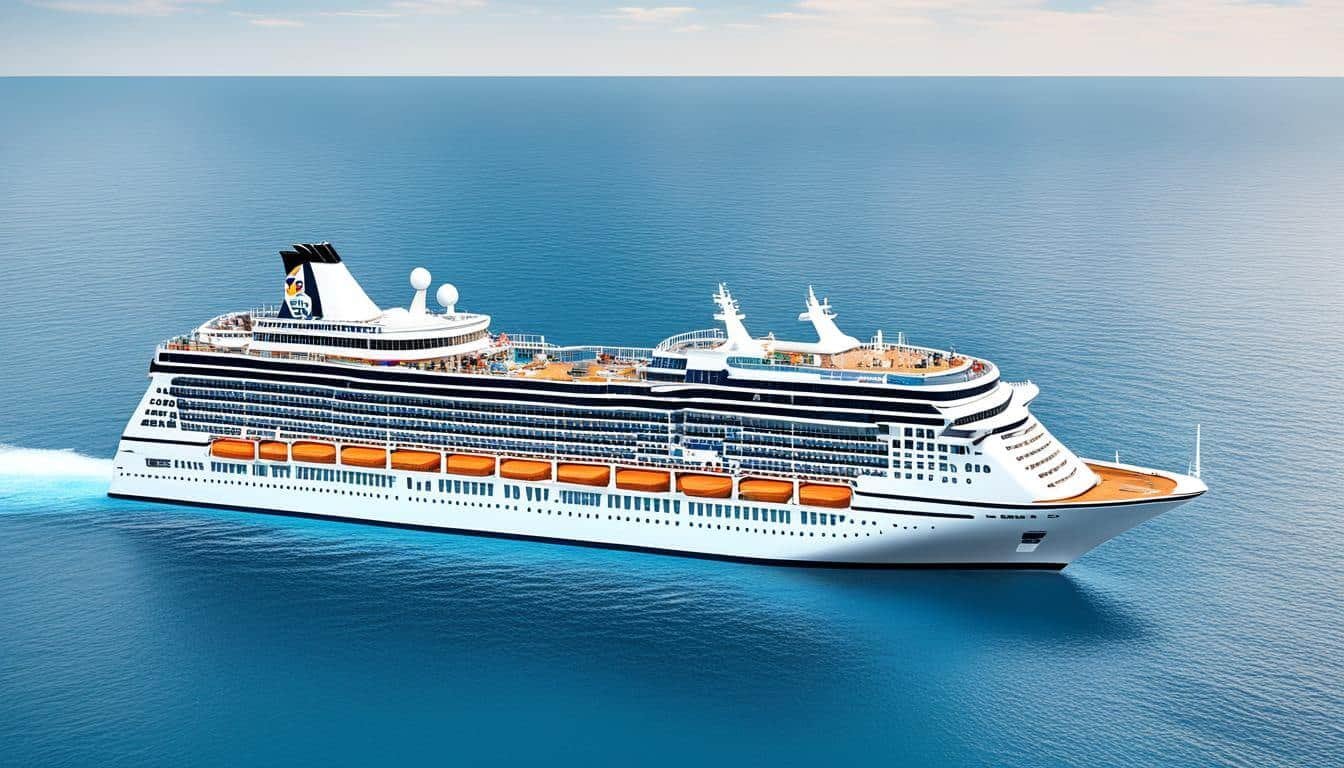
Cruise ships are also made very carefully, following strict rules. They are checked often to make sure they are safe. The ships use strong materials like reinforced steel. This makes them tough and safe. All these features, from compartments to high-tech systems, keep a cruise ship steady. They help the ship stay sailing, even through rough seas. The goal is to keep everyone on board safe and sound.
Ingenious Engineering
Cruise ships float due to smart engineering. They use the science of buoyancy, hull shape, and more. This design allows cruise ships to carry many people safely across oceans.
The main reason for a cruise ship’s ability to float is buoyancy. When a ship is placed in water, it pushes water aside. This action creates an upward force, keeping the ship above water.
The hull shape is vital for a ship’s buoyancy. With a curved design, it moves through water easily. This helps the ship stay afloat without a lot of effort. Careful weight placement keeps the ship steady in the water. The ship’s heaviest parts are low down to stop it from tipping. This smart design helps the ship stay balanced.
Strong, light materials like steel are used in building cruise ships. This keeps them buoyant and strong. They are built to last, while still floating well. Safety is key in cruise ship design. They have watertight compartments to prevent sinking. These compartments keep the ship floating, even if part of it fills with water.
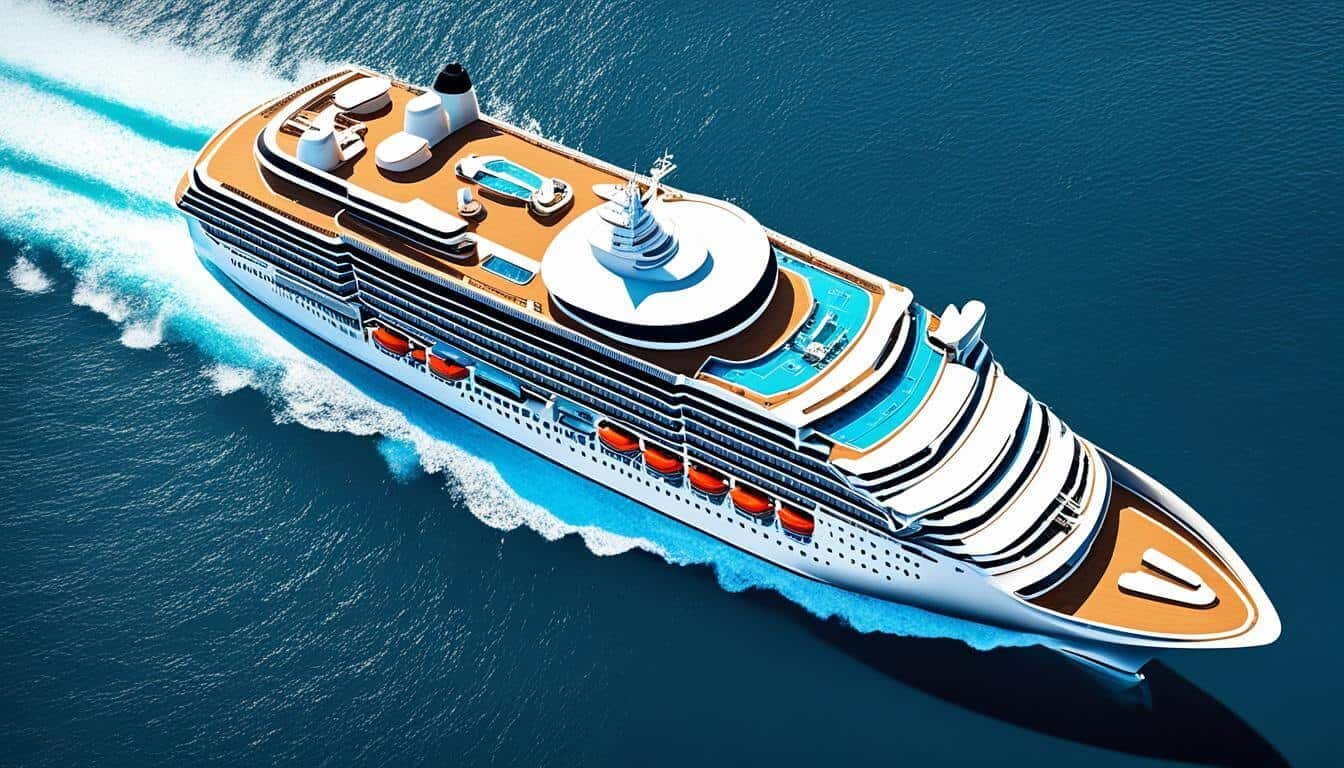
All these parts work together to make cruise ships safe and enjoyable. They are designed to float well and offer a remarkable journey to their passengers.
The Physics of Flotation
Flotation is based on buoyancy and density. Buoyancy is the force that pushes up on something in water. Density shows how tightly packed the material in an object is. If something is to float, it has to be lighter than the liquid it’s in.
Cruise ships are made to be lighter than the water. This lets them stay on top and not sink. They’re also built in a way that keeps them balanced and steady. This way, they won’t tip over easily. The design and how things are placed on the ship are very important for safety.
On a cruise ship, buoyancy helps it not sink. It counters the pull of gravity. By spreading out the ship’s weight, the force of the water holds it up. The curved shape of the ship guides water in a way that helps keep it up. So, the ship is not just in the water; it’s sort of pushed up by the water itself.
Weight Distribution
The way weight is spread on a cruise ship is vital for its safety. Heavy things are put lower in the ship. This makes sure the ship doesn’t lean too much. If it leans, it could be in danger of tipping over. A well-distributed weight keeps the ship level on the water.
Making ships out of strong, but lightweight materials also keeps them afloat. Steel, for example, is used because it is not very heavy but is extremely sturdy. This means ships can be heavy enough to stay upright but light enough to float above water.
In all, the physics of flotation talks about buoyancy and density. Cruise ships are carefully put together so they don’t sink. They are made with the right materials and design. This makes it possible for them to sail smoothly. Passengers get to enjoy amazing journeys because of this smart design.
Conclusion
Cruise ships are marvels of engineering that stay afloat due to the principle of cruise ship buoyancy. They use the design of their hull, the right materials, and safety features to float on water. This understanding makes us admire the incredible work behind building these great ships.
Their buoyancy is thanks to clever design. This includes how weight is spread and materials like steel that are used. Safety measures, such as watertight rooms, keep the ship safe in emergencies, making sure it stays up.
Knowing about the technology that keeps these ships floating makes the sea adventure more amazing. So, the next time you’re on a cruise ship, think about the awesome engineering that lets it move through the sea.
FAQ
How do cruise ships float?
Cruise ships float thanks to the principle of buoyancy. This is when the force of water pushing up on the ship is more than the ship’s weight. So, it stays on top of the water.
What is the principle of buoyancy?
The buoyancy principle says that any object in water gets a force pushing it up. This force is the same as the weight of the water the object pushes aside. This is why things can float.
How does buoyancy work on cruise ships?
On cruise ships, buoyancy means the water they push aside weighs as much as or more than the ship. A balance of these forces lets the ship stay afloat.
What role does the shape of the hull play in a cruise ship’s ability to float?
The hull’s shape is key for a cruise ship to float. It has a big, rounded front and a slim back to cut through water easily. This makes a lift that helps keep the ship up.
How does weight distribution and construction materials contribute to a cruise ship’s ability to float?
The way weight is spread and the materials used are vital for a ship to be stable. Ships are built low and keep weight even to not tip over. Also, sturdy but light steel is used to build them.
What safety features do cruise ships have to ensure they remain afloat?
Cruise ships use sealed-off watertight parts to stay buoyant if their hull breaks. These areas keep water out and help the ship stay afloat.
How does ingenious engineering contribute to the ability of cruise ships to float?
Smart engineering designs and builds cruise ships. They use many ideas to make sure ships float well, like buoyancy, weight balance, hull shape, and safety measures.
What is the physics behind the flotation of cruise ships?
Cruise ships float because they are lighter than the water they’re in. They’re carefully built to stay balanced and not tip over, using what we know about water and objects.
